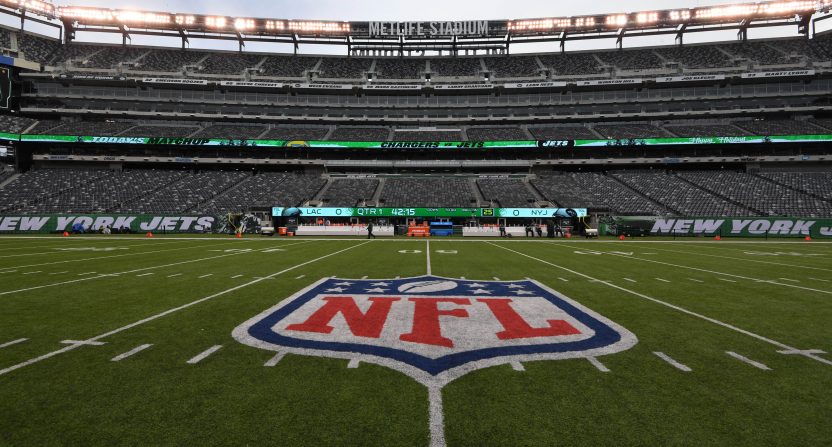Most of the discussion around the NFL expanding its TV inventory has revolved around proposals of a 17-week season and more international games, both of which carry some potential downsides. But Wednesday saw a notable twist there, with ESPN’s Adam Schefter reporting that the league is also looking to add two playoff teams each year (one in each conference) and remove the bye for the second-place team in each conference, creating two more wild card games each year (one in each conference).
NFL playoff structure is about to be changed. Under the current CBA proposal, seven teams from each conference will make the playoffs, with only bye per conference, sources tell ESPN. It would go into effect this upcoming season. More coming on https://t.co/rDZaVFhcDQ.
— Adam Schefter (@AdamSchefter) February 19, 2020
More details: Under the current CBA proposal that NFL owners are pushing for, the playoff field would be expanded to seven teams, while the regular season would be increased to 17 games per team, and the preseason shortened to three games per team, per sources.
— Adam Schefter (@AdamSchefter) February 19, 2020
That has a lot of implications, but it’s perhaps particularly notable for the significance of adding two more wild-card games for TV. And that’s a big deal given how well the wild card games draw. Every current wild card window grew in 2019, and this year saw gains for ABC/ESPN, CBS, and Fox, but a slight drop at NBC. Here are the audiences for this year’s wild card games:
It seems likely these new games might be thrown into tripleheaders on Saturday and Sunday. This year’s wild-card games were played at 4:35 p.m. Eastern (Buffalo-Houston) and 8:15 p.m. Eastern (Tennessee-New England) Saturday, and at 1:05 p.m. Eastern (Minnesota-New Orleans) and 4:40 p.m. Eastern (Seattle-Philadelphia) Sunday; it’s not hard to see another game around 1 p.m. Eastern Saturday and around 8:20 p.m. or so Eastern Sunday. Making both days of wild-card weekend a triple-header would probably dilute the audience for each game by a little bit, but there’s still going to be a big audience here (and it’s interesting that quite a few of the teams that would have made the playoffs under this system over the past few years are significant TV draws; see this post for a couple of different looks at how teams ranked as national draws heading into this season). So there’s more apparent merit to this than the latest proposal for MLB playoff expansion, which would just add some weekday games.
And the audience here is much bigger. Even the down year-over-year NBC game pulled in the biggest audience of the weekend, and the most viewers for anything on TV since the past Super Bowl. And while the divisional round and conference championship games (not to mention the Super Bowl) draw more than the wild card games, the wild card games still pull in a whole lot of viewers, and you can bet that each of the league’s TV partners would love to have another wild card game to broadcast. So if this proposal is accepted by the players (and it may well be; Sports Business Journal’s Ben Fischer wrote Wednesday that there’s “reason to believe an NFL/NFLPA deal is very close”), the league’s going to be pulling in a fair bit more revenue immediately from selling these packages for 2020-21 and 2021-22, and then perhaps even more in the next round of TV deals (the Monday Night Football deal expires after 2021-22, while the CBS, Fox and NBC packages expire after 2022-23).
The latest
Yes, this plan provides for another playoff team, but it gives the #1 seed (and the only remaining bye) a lot of importance relative to the #2 seed. Newsday‘s Nick Klopsis wrote in December 2018 that only 4.7 percent of teams playing on wild card weekend since 2002 had won three straight games to advance to the Super Bowl (however, all six of the teams that did make it that far won). 2019 (#2 versus #2) and 2020 (#1 versus #2) continued that trend. And a 2013 NFL look at Super Bowl champions from 1990-2012 found nine top-seeded champs, six second-seeded ones, and eight from seeds three through six. So the new wild card teams could get to the Super Bowl, but what seems even more likely here is that the #1 seed dominance expands even further. And that makes playing well in the regular season and winning that top seed and first-round bye even more important.
Also. a playoff expansion does mean more teams will be viewed as possibly playoff-bound early on, and more teams will be in actual playoff contention late in the season. That, plus the dramatically increased importance of the #1 seed under this system, could add a lot more fan interest (and thus, viewership) to late-season games. So that’s a nice feature for the league and its broadcast partners as well.
And the real bottom line here is that an extra pair of playoff games will likely add a lot of TV money (and ticket money, and concession money, and parking money, but especially TV money) to the league’s coffers, and that it seems likely networks will pay that price (especially with how well NFL ratings are holding up compared to much of the rest of TV). That adds strong incentive for the owners to do something like this. We’ll see if the players wind up agreeing to it or not, but there are a lot of dollar signs seemingly in support of this plan, so that would seem to give it a decent chance.








